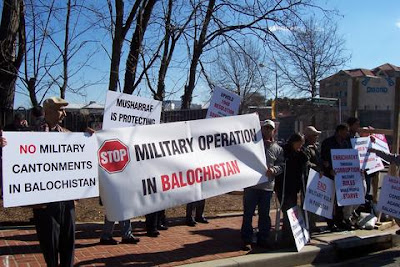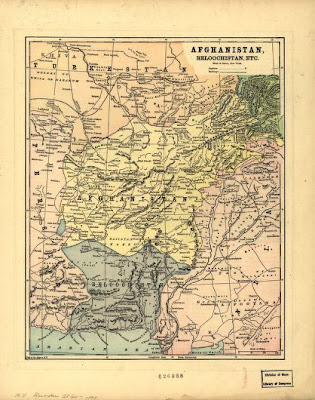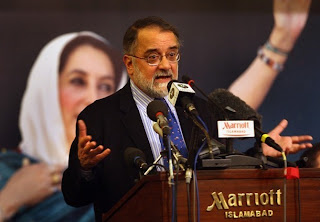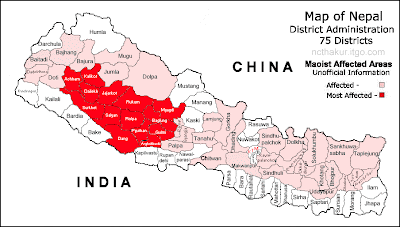I had conducted this interview with Dr. Wahid Baloch so that all of us can get a first hand report on the issues that plague Balochistan. Whatever we read in mainstream media, glosses over or does not report at all the scale of atrocities that Pakistan Army inflicts on the Balochis while robbing / stripping them literally off their assets.
Preamble:
Populated by fiercely independent Baluch warriors, Kalat retained much of its independence from the British. Regarded as too wild to tame but a useful buffer against Russians, the Baluch were allowed to keep their sovereignty.
Just six months of independence, the Pakistani military stormed in and forced Kalat to cede to Pakistan. Baluchi separatists have since fought five insurgencies to try to claw back their independence from Pakistan’s central government, which has responded with massacres, large scale disappearances and torture, inclusive of local rulers like Bughti, a secular soft spoken; Oxford educated leader who wanted independence from Pakistan and as such was assassinated by the Pakistan Military.
Read this statement by ASIAN HUMAN RIGHTS COMMISSION - PAKISTAN: Fingers point at state intelligence agencies in the killings of three Baloch nationalist leaders.
Main worry is that the continued repression of the Baluch, coupled with the de facto silencing of their tribal leaders, is forcing many formerly secular separatists into the arms of the Taliban / Al Qaeda instead.
Until recently, The Taliban have held little sway over the Baluchi tribes. But Islamic radicalism appears to be spreading through the region. Taliban leaders recently announced the creation of a new group, “Tehreek-e-Taliban Baluchistan”.
The shift to Taliban is not large scale, the Balochis themselves are largely secular, have a royal gait and demeanor. We now delve into the interview to make sense of the constantly shifting landscape to the west of India.

Q1. Please introduce yourself?

My Name is Wahid Baloch. I'm the president of Baloch Society of North America, an organization dedicated to highlight the plights of Baloch people in Iranian and Pakistani occupied Balochistan. I'm a US citizen, originally from Balochistan.
Q2. Can you please tell me your organization's aim?
Baloch Society of North America is the first Baloch political organization that was created in US on March 2005. The aim was to educate the American people and the world community against the Pakistani and Iranian illegal occupation of Balochistan and exploitation of Baloch resources and to bring their human right violations in Balochistan into the world notice. By doing so, we have done a great job in such a short span of time.
Q3. I have a flag here (dated 1893) which depicts Balochistan as a separate country? How did it become part of Pakistan?

Balochistan was never a part of India but was separate country and it had enjoyed bilateral relationship with British Government. When British left the Indian subcontinent, Balochistan emerged as an independent state on August 12, 1947. Pakistani army, after 7 and 1/2 months, attacked the sovereign Balochistan and occupied it on March 27, 1948 at gun point. Since then Balochs are fighting for their independence. The war of independence continue as we speak.

Q4. Why do you then consider the "occupation of Pakistan" illegal?
As I said, Balochistan was an independent free sovereign state even before Pakistan was carved out of India in 1947. Baloch people were not a part of Indian Muslim League's movement to create Pakistan. Balochistan was forcefully annexed into Pakistan against the wishes of Baloch people. Pakistan is in violation of international law for its continuous illegal occupation of Balochistan and exploitation of Baloch resources without Baloch consent.
Baloch do not consider themselves as Pakistani. We are a secular nation. We should not be forced to live in with Islamic terrorists and extremists in Pakistan. We have nothing in common with Islamic Pakistan. Our culture, language and traditions are completely different from that of Pakistan. We are fighting for our freedom that Pakistan has taken away from us.
Pakistani army has committed war crimes against the Baloch people in Balochistan. These war crimes include indiscriminate bombing women and children, use of chemical weapons, rape, torture, murder, disappearances and displacement of thousands of Baloch people, testing its nuclear weapons in Balochistan, rendering hundreds of miles of Baloch land into waste, leading to the spread of diseases such as increased number of abnormal birth defects and glaucoma due to spread of radio active materials. Thousand of nomadic lives have perished because of the effects of the Nuclear holocaust. These and many other crimes are well documented by independent human rights organizations. They all constitute crimes against humanity and call for international intervention and action that is long overdue.
Q5. Under the terms of agreement, Pakistan was to reimburse proceeds from gas sales which originated from Balochistan. Has Pakistan honored this commitment?
I'm not aware of any such agreement between the Baloch leaders and Pakistani Government. Whatever Pakistan is doing or has done with Baloch resources are a clear loot and plunder at gun point. Pakistan owes the Baloch people trillions of dollars for illegally occupying Baloch land, exploiting Baloch resources for the last 61 years and for testing its nuclear weapons on Baloch soil without the Baloch consent. Pakistani army must leave Balochistan peacefully without any further bloodshed . Balochistan's sovereignty must be restored as an independent secular state according to the international law as it was in 1947 prior to the Pakistani occupation. Pakistan must pay restitutions to thousands of Baloch families whose loved ones were killed, tortured, murdered, jailed or made disappeared by Pakistani army and its ISI.
Q6. In your quest for freedom struggle, how do you get to aim to fight Pakistan forces, which is one of strongest in the world? How would term the success / failure of the movement till now?
A strong or big army can not be defeated merely by being strong militarily alone but it also needs the will-power and determination of people too. Baloch people have demonstrated that will-power and have grown stronger and stronger everyday in their determination to defeat Pakistani and Iranian occupying forces. Baloch people may have lost few battles due to the lack of training and resources and lack of international help but we have not lost the war. The war for freedom continues and with everyday, Baloch's will to liberate their land from these occupying forces is getting stronger and stronger. Every Baloch is determined to fight to the last drop of his blood to free their land from the Pakistani and Iranian occupiers. We ask all the freedom loving Nations to support Baloch peoples in their just cause.
Q7. Pakistan claims that yours is a terrorist movement funded by outside countries (namely USA, India and even Russia). Your views.
Pakistan can calls us whatever she likes, but the fact is that we are not terrorists or separatists. We are freedom fighters, fighting for our freedom that has been taken away from us by Pakistan and Iran.
In fact, Pakistan and Iran, both are itself terrorist states and are sponsoring global jihad and Islamic terrorism. Pakistan is the epicenter of terror. Wherever there is a terrorism, Pakistan's foot prints are found there.
Q8. In this link (CLICK HERE), it is mentioned that Akbar Bugti died from a shell that backfired. Your views?
These are Pakistani propaganda to mislead and hide the facts. Nawab Akbar Khan Bugti was killed along with his companions and body guards by Pakistan's army in a massive military operation by Pakistan's army on August 26, 2009. Baloch Nation lost a great leader but his great grandson Brhamdagh Bugti is still with us, fighting for Balochistan and we fully support him.
Q9. Pakistan is today facing an existential threat from Taliban, who too are entrenched inside Baluchsitan. How to aim to "cleanse" Baluchistan?
Taliban were created by Pakistani ISI and they have been nurturing and supporting them all this time. It will be naive to believe that Pakistani army will ever take any action against its own created ideological friends. It is no secret that Taliban's top leader Mullah Omar is hiding in Quetta with full ISI knowledge and support. As long as Pakistan exists Taliban are going no where and they will continue to bleed the NATO forces and Afghanistan, and the dream of a peaceful democratic Afghanistan will remain a distant reality.
In order to eliminate Taliban, the main sanctuary, Pakistan, must be be eliminated first. Their safe heavens inside Pakistan must be dismantled and their main sponsors and financier Pakistani Jihadi army and ISI must be defeated.
Let's not be too enthusiastic that Pakistan Jihadi army will defeat or eliminate its own created Taliban. Taliban are a big asset and a great source of income for Pakistan's army. I suggest the American and NATO forces in Afghanistan to take the matter in their own hand and go in into Balochistan along with secular Baloch on their side to finish Taliban sanctuaries by themselves.
A peaceful Balkanization of Pakistan on ethnic lines and creation of an independent Democratic Secular United Balochistan is the ultimate answer. This will limit and weaken both Pakistan and Iran's quest in their nuclear adventures and reduce their capablity to support and spread the Islamic extremism and fundamentalism in the region.
We will stand with the NATO forces and world community to do the job that needs to be done. Nothing else will work. Let's not waste time and money on Pakistan any more. This terrorist country with its pan-Islamic terrorist ideology should not have been born to begin with. This country is a curse for the entire region. It is the most corrupt country on the face of earth.

NOTE: THE HIGH SPEED TRAIN CORRIDOR FROM GWADAR TO CHINA - STILL ON PAPER!
Q10. Gwadar is a port built in Balochistan with help from China. If we give you the hypothetical situation that Balochistan is liberated, how would you want to use the port? Will you allow Chinese navy berthing rights in Gwadar?
We will use the port to benefit our people. We will facilitate the trade and business of South Asian countries to promote peace and friendship among nations in the region. Currently China is working with Pakistan to crush the Baloch freedom movement. We are not against China but China must stop supporting Pakistani army against Baloch freedom fighters. A free united Balochistan will extend a hand of friendship to all of those Nations who have helped us to liberate our land from the Pakistani and Iranian occupiers.
=============================================














